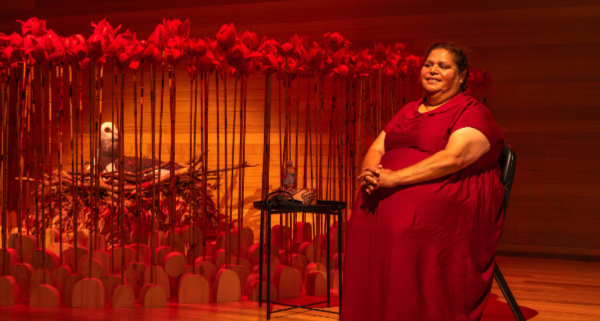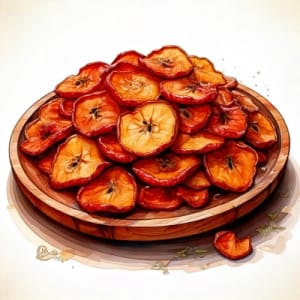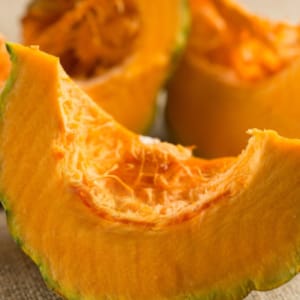My Triangle – Cheryl Davison
 The Windsong Pavilion was full when Cheryl Davison explained the meaning and technique of Warigamban, her recent exhibition at Four Winds, that featured The Forest, a huge floor to ceiling screen print on Turkish linen, and Wonga Waratah, telling the story of the wonga pigeon and how the waratah became red.‘Welcome everyone. Walawaani. It’s such an honour to bring this work to the local community. The Forest was commissioned for the Bagan Bariwariganyan exhibition at Bundanon, and the Wonga Waratah was commissioned by the Basil Sellers Exhibition Centre in Moruya a few years ago. It’s lovely to bring it out of the closet where it’s been stored for a couple of years now. I know a lot of people didn’t get to Bundanon or missed out on the Bas, so I’m really honoured to be able to bring it here for everyone.
The Windsong Pavilion was full when Cheryl Davison explained the meaning and technique of Warigamban, her recent exhibition at Four Winds, that featured The Forest, a huge floor to ceiling screen print on Turkish linen, and Wonga Waratah, telling the story of the wonga pigeon and how the waratah became red.‘Welcome everyone. Walawaani. It’s such an honour to bring this work to the local community. The Forest was commissioned for the Bagan Bariwariganyan exhibition at Bundanon, and the Wonga Waratah was commissioned by the Basil Sellers Exhibition Centre in Moruya a few years ago. It’s lovely to bring it out of the closet where it’s been stored for a couple of years now. I know a lot of people didn’t get to Bundanon or missed out on the Bas, so I’m really honoured to be able to bring it here for everyone.
‘When I was first asked to do a piece on country, I wanted to honour the ancestors in a way that tells part of their story of traveling into country. There’s no better way to tell that story than through some of their cultural practices. Breadmaking brought a lot of our mob together – the South Coast people, the Yuin people, made up of thirteen tribes from Sydney all the way down to Victoria border. We also transit across the border and into East Gippsland. My family connections go into Monero Country, and one of our journeys in that country was to travel along the Snowy River from Kosciuszko down to Orbost and to the coast. That’s my grandmother’s family.
‘The Forest talks about our travel in the country, our journeys to places, settling in and using the resources to make the bread. Our burrawang forests are very vast and prolific. The animals spread the seeds, and burrawangs drop seeds and propagate themselves, but I would say that our own people and their practices helped the forests flourish.
‘At a certain time of year, men and women would travel to collect lomandra or sedge rush that grows in creeks and water, to make baskets. Once they were made, they were actually placed back into the water. They would have settled in an area next to a running creek. The whole family would go out and collect the burrowang nuts and place them in the baskets in the running creek to wash all of the poison out. That process takes maybe two or three weeks before the seed is ready. In the meantime, the family are in that area living off the land, catching fish and kangaroo just waiting for the nuts to be leached of all their poisons. Don’t try this at home! One of the indicators of the nut being ready is that the little fish then come around and start to nibble.
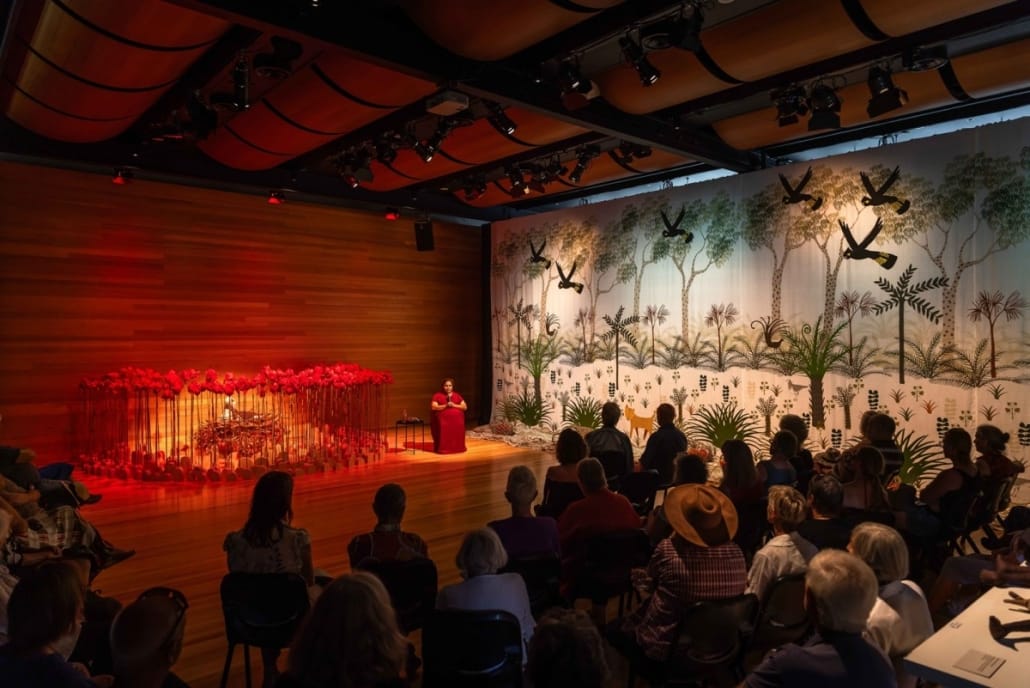
Cheryl Davison speaking to the audience between the two installations – Wonga Waratah and The Forest Photo: David Rogers
‘As you can see, I’ve considered everything in this piece. Nothing is an accident. The fish are in there for a reason. Once the fish had shown the nuts were ready, they came out of the water and were ground into flour, and then they were cooked into beautiful dampers or little biscuits in our ground ovens or straight on the coals. Flour was also made from the hard yellow lomandra seed.
‘When I thought about this stuff, I knew it started off with the baskets, and they were intended to be really big and the actual artwork but then, as it evolved, I decided to have a backdrop and show the whole forest. The baskets were actually made by Donald Atkinson, who is a basket maker. I’m an artist and a screen printer, and I dabble in a lot of things. I love fabrics, and I love dyes, and I love Earth dyes, and I love country, so this really speaks about my love for country. A little dingo is often in my pieces and is really about my lore and about integrity for the work and how I do it, doing things right culturally.
‘At times I just sit in the forest. I guess it’s my way of healing, sitting in quietness and feeling my ancestors around me. These days, our families, and certainly my family, we have a lot of trauma. Driving into the bush and just sitting in spaces helps me clear my head of stuff and rejuvenate. At the same time, I worry about our country as well. I’ve taken my daughter to places that I go to, and I say, “Look, really look at this place. Look how the trees and the bush start off with these beautiful dark colours, and as you look further into the bush, they become pastel and light.” I say to my daughter that we don’t know how long we have access to these places, because we always feel like we’re being fenced out, gated out from the places that make us feel well. So, in this piece there is sadness and worry, but it’s also about healing and family and knowing the way our families moved into these places happy and without a worry in the world, because they knew everything about country.
‘Since 2019 we’ve been working in language. Language brings a whole new meaning to the pieces that I do. I imagine that our people would have been singing about these practices. Singing was the way that they remembered how to treat the burrowang nut. The song lines are very important to us to remember how things are done and why it’s important that those little fish are not fished out and why it’s important to make sure that the streams are running. I think a lot of people really underestimate the power of those song lines, because that is the way that our people have learned these practices for thousands of generations without getting it wrong. If you eat a burrowang nut, or try to make bread, you’ll probably die if you don’t know how to treat the nuts to leach out the toxins. So, it’s really important for those songs to be sung in ceremony, so that the kids learn and the next generation learn the practice. All of a sudden, it all makes sense to me. Learning the language, learning about song lines, even this piece here today is about knowing our practices. Our old people have been keeping those practices alive verbally and through song and song lines.
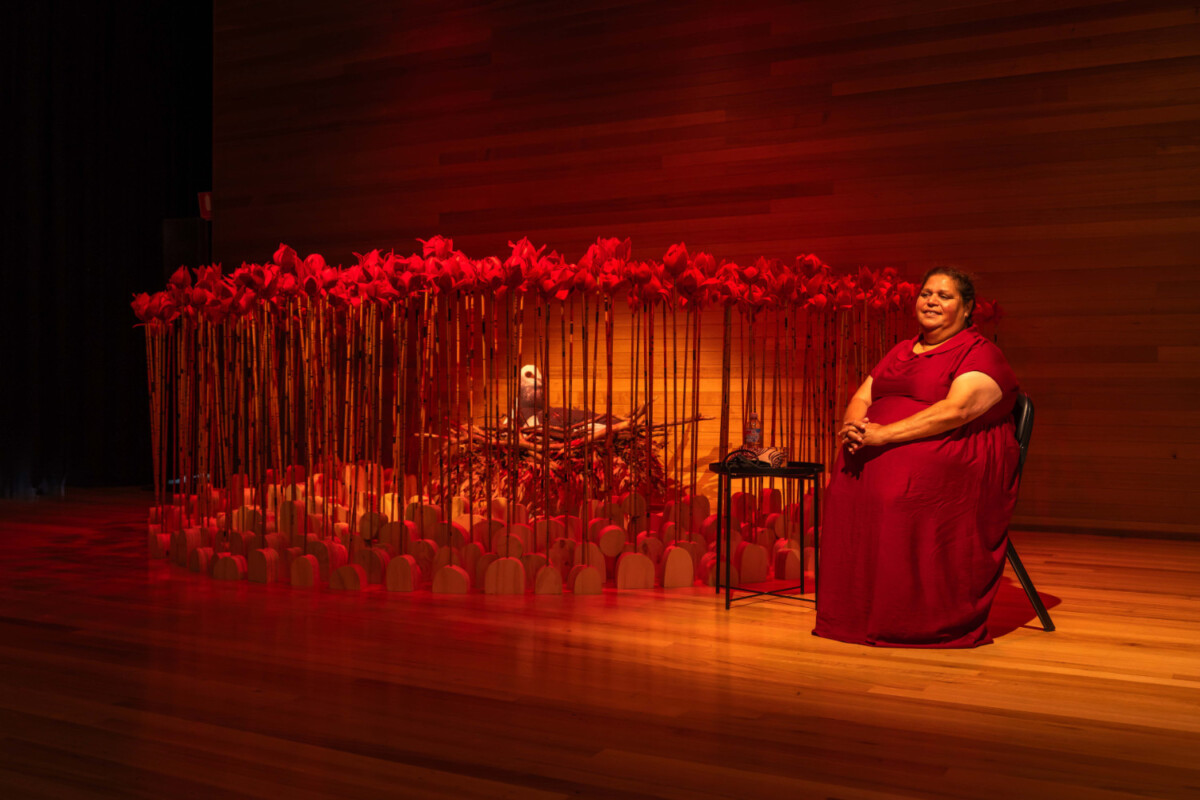
Cheryl Davison with Wonga Waratah
‘A wonga pigeon crossed the road in front of us on our way here today. There’s a sign, I said. We hear that pigeon everywhere, and her story is taught to children and young girls and is about motherhood. I once told artist Indira Carmichael that I wanted to see a room full of waratahs to tell the story of the wonga. A few years later, she said she was going to make that happen, and we applied for funding to get it produced and were successful.
‘The story about the wonga starts with her sitting in her nest waiting patiently all day for her husband to come back. As the day went on, she started to get worried that she couldn’t hear him and she couldn’t see him. She went against her instinct and jumped out of her nest and went looking for him. She walked all through the bush, just singing out his name, and never got a reply. She couldn’t hear him and couldn’t see him. Wongas are fat little birds, like little hens, and don’t fly very high. They very rarely fly up into the trees high and just stick close to the ground.
Because she couldn’t find or hear her husband, she thought, I’ll fly up above the tree line and I’ll have a little scout around. She flew up and was looking around but couldn’t see or hear her husband anywhere. But a hawk had seen her, and so he came down, he grabbed her and he started flying through the forest with her. Because she’s a little fat bird, she’s getting heavy and he’s trying to fly to carry her back to his nest. She’s getting heavier and heavier so he’s holding her tighter and tighter, sticking his talons into her wing to try and get a tighter grip. As he’s flying through the forest, blood starts to drip out of her wing. She’s too heavy and just falls out of his grip and tumbles down, falling on a bed of white waratahs. In the dream time, the waratahs weren’t red, they were white. She’s on the waratah and she’s got a broken wing. Her wing is bleeding, and the only way she can get home is to jump from waratah to waratah to waratah dropping blood on each as she goes. And that’s how the waratah become red.
‘I think the main thing that I do in my practice is telling my story about my people. It’s very innocent. The style of art I do is probably what you would call innocent art. It’s very simple yet impactful and it tells a story.’
Caption for photo top right: ‘Warigamban – A Long Time Ago Installation’ by Cheryl Davison
Excerpts from Cheryl Davison’s artist talk at Four Winds. You can also hear some of this talk on The Triangle Community News podcast.
